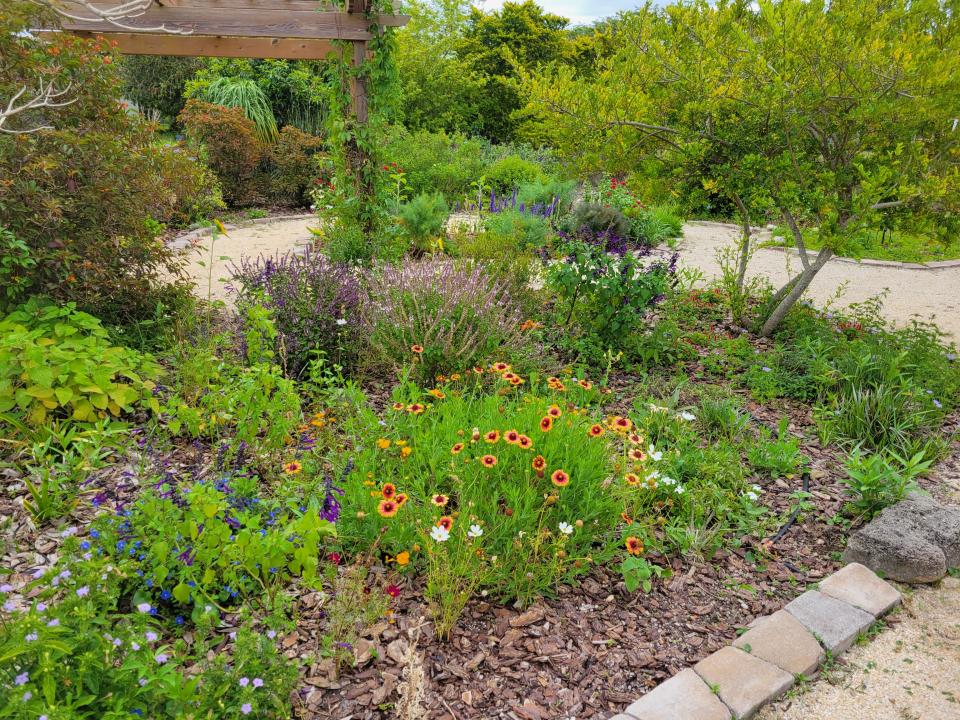Protecting trees, promoting biodiversity in yards can help forestall climate change
My childhood home in Vermont included a backyard that opened up to a trail through the woods. Perhaps it was an old logging or sugaring trail. After school, that road led me into a separate world, one only with trees and wildlife.
In the spring, the brook gurgled beside the pathway; in summer, the maples, birch and poplars offered shade from that “hot” Vermont summer sun; fall found me shuffling through fallen leaves; winters I snowshoed or skied along the open pathway.
Something about the woods has always drawn me. In Gainesville my house backs up onto a small wetland with maples, cedars, pines and cypress. Windows face that direction, drawing my imagination back to the woods. They offer me hope for this planet.
Saving and restoring our old forests and planting trees in our landscapes can help forestall climate change. The Intergovernmental Panel on Climate Change, a United Nations committee that focuses on the science of climate change, recently released its third section of its report, “Mitigation of Climate Change." The panel affirms we can keep our temperatures below a 2 degree Celsius increase.
After considering these findings, I thought of the old forests of Vancouver Island and the deforestation of the Amazon. We must try to mitigate our climate crisis by keeping our lands from being deforested.
Between 16% and 30% of the carbon in our atmosphere can be sequestered in our forests, according to several different sources. While reforestation alone is not the solution, it — combined with many other actions — can reduce the threat of rising temperatures.
Alachua County citizens were ahead of the game when in 2016 they voted in favor of a half-cent sales tax to be used to conserve environmentally sensitive lands and to maintain and establish new parks. By saving these spaces, Gainesville and Alachua County are keeping lands from further development. In 2020, 90% of the county’s portion of these funds went to conserving land.
At the United Nations Conference on Climate Change, COP26, deforestation was recognized as a major issue. Countries formally acknowledged the need to protect, conserve and restore nature and ecosystems including forests and other terrestrial and marine ecosystems. Many countries have since pledged to stop deforestation and focus on reforestation.
More from Susan Nugent:
Florida lawmakers have rejected legislation that would lead us to clean energy future
All Floridians will find their lives changed by rising and warming seas
Bipartisanship must prevail in efforts to address the climate crisis
In 2020, countries saw great loss of tree cover. Brazil had the greatest loss with over 1.6 million hectares cut. Maps of global tree cover loss indicate Florida is not blameless, nor is Alachua County. Our losses here are primarily due to urbanization, according to Global Forest Watch in 2020. Anyone driving west of Haile will quickly see how our county is rapidly growing, destroying trees in the process.
At COP26, over 130 countries pledged to stop deforestation. These countries account for almost 90% of the world’s forests. Brazil, home to the Amazon rainforest, signed this pledge, but declined to stop reforestation until 2028.
Another way to mitigate climate change is to promote biodiversity in our own yards. Presently the United States has approximately 41 million acres of lawn. We are raising, watering, fertilizing, spraying pesticides, mowing and creating a crop that benefits no one or thing. Lawns are the antithesis of biodiversity.

As a Master Gardener, I have long spoken and written about the benefits to our yards, to our waterways and to our pollinators of maintaining a Florida-Friendly Landscaping. Florida-Friendly Landscaping has not changed. But rather, homeowners can now work with their homeowner associations (HOAs) to establish such a landscape in their yards.
Homeowners must go through any HOA process to change the front or back yard. But if a homeowner can show that what the HOA has required is not the right plant for the right place, he or she can propose an alternative that would work.
For example, many HOAs want front yards to have lawns. Forested yards replace turf. However, shade and turf do not work well together. Now a homeowner can propose an alternative ground cover to fill this problem area and to support pollinators in the process.
Other states are also making way for environmentally friendly gardening principles to be used in their yards. Many ground covers need little mowing, further lowering the carbon released into our atmosphere. Fewer pesticides, less water use and less fertilizer along with diversity of plants will help clean our waterways and feed our pollinators.
Promoting biodiversity is essential to our pollinators, the source of so many of our foods. We can all praise Alachua County for its conservation of lands, and we can urge both our county and city to do more. In turn, we can make sure our own properties promote biodiversity.

As the IPCC report says again and again: The time is now. We cannot wait.
Susan Nugent is a Climate Reality Project leader from Gainesville.
Join the conversation
Send a letter to the editor (up to 200 words) to letters@gainesville.com. Letters must include the writer's full name and city of residence. Additional guidelines for submitting letters and longer guest columns can be found at bit.ly/sunopinionguidelines.
Journalism matters. Your support matters.
Get a digital subscription to the Gainesville Sun. Includes must-see content on Gainesville.com and Gatorsports.com, breaking news and updates on all your devices, and access to the eEdition. Visit www.gainesville.com/subscribenow to sign up.
This article originally appeared on The Gainesville Sun: Susan Nugent: Forests, biodiversity can help forestall climate change

